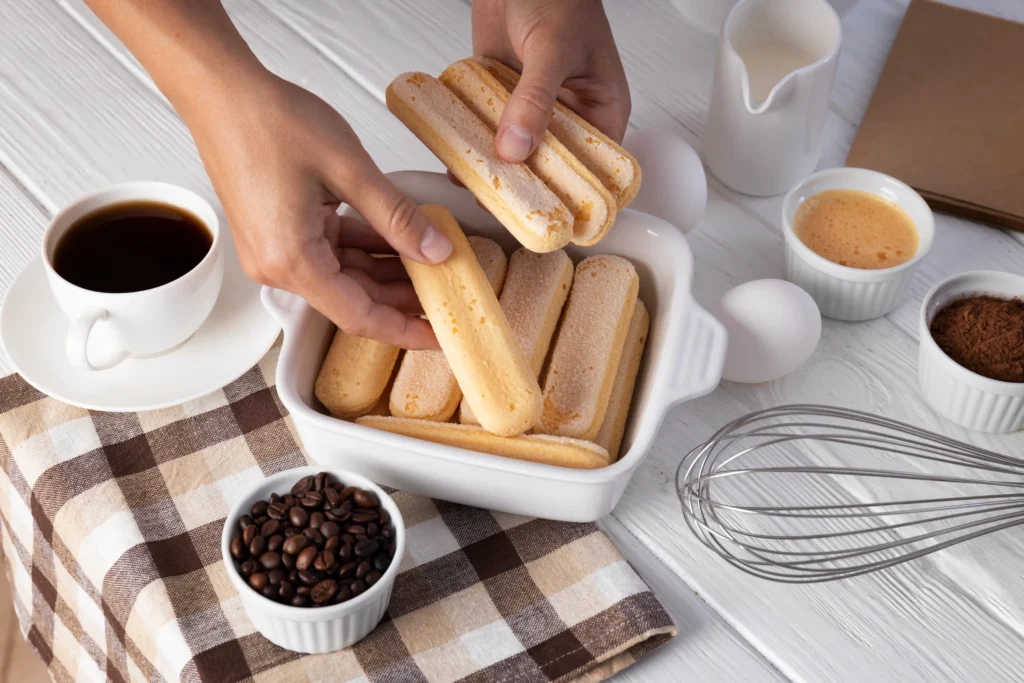Lady finger cookies, known for their light texture and unique form, have become a beloved ingredient in desserts around the world. These slender, crisp treats hold a special place in various cultural traditions, from Italy’s savoiardi to France’s biscuits à la cuillère. But have you ever wondered, where did lady finger cookies originate? This article delves into their origins, history, and evolution, explaining how they spread globally and became essential components in many iconic desserts.
Table of Contents
Understanding Lady Finger Cookies
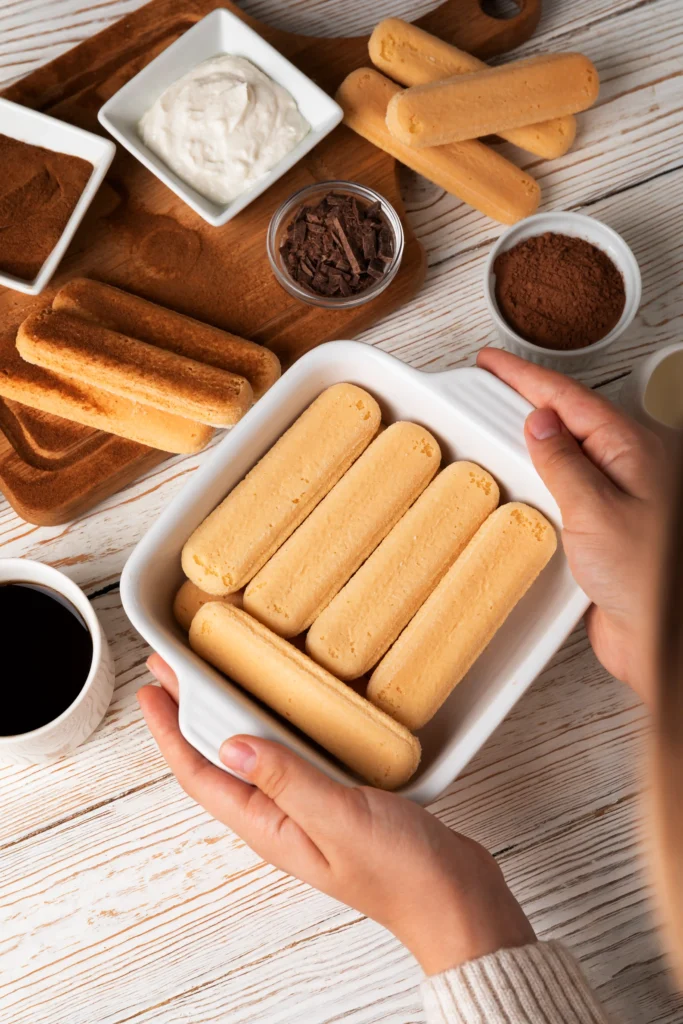
What Are Lady Finger Cookies?
Lady finger cookies, also called sponge biscuits or savoiardi, are light, airy cookies that often serve as the base in layered desserts. The name “lady finger” comes from their slender, finger-like shape. People know these biscuits for their delicate crunch, lightness, and ability to absorb liquids without losing shape, which makes them ideal for many desserts. In addition to their use in desserts, these cookies have a long shelf life, making them easy to store and use at any time.
The Unique Shape and Texture
Lady finger cookies have a long, slender shape that allows them to absorb liquid while holding up well. This feature makes them perfect for layered desserts like tiramisu. The light, sponge-like texture results from whipping egg whites into the batter, creating a fluffy, airy product. The crispiness of the cookie is enhanced by the process of baking at a low temperature, which ensures that the cookies dry out without becoming too hard.
The Light and Crispy Nature
Lady finger cookies stand apart from traditional cookies. They aren’t dense or hard. Instead, they offer a delicate, melt-in-your-mouth quality. The sugar and flour mixture bakes lightly into a thin, crisp shell that crumbles easily. This texture makes lady finger cookies perfect for soaking up flavors without becoming soggy. Unlike regular cookies, which tend to get soft or soggy when wet, lady fingers retain their shape and crispness even when immersed in liquids like coffee or liqueur.
Origins of Lady Finger Cookies
Early History
Lady finger cookies date back to the 17th century in Italy. These cookies likely originated as simple yet elegant treats for the Italian aristocracy. Originally called savoiardi (meaning “from Savoy”), they appeared at royal banquets and celebrations to impress guests. The creation of these cookies is attributed to the region of Savoy, located in the Alps, which at the time was part of the Duchy of Savoy, an area that included parts of modern-day Italy and France. Their light and refined nature made them a perfect fit for the sophisticated tastes of the nobility.
The Role of Lady Finger Cookies in Italy
Italy has always been a center of culinary creativity, and lady finger cookies reflect this tradition. The Savoy region, now part of both Italy and France, is credited with creating these biscuits. Italian chefs used lady fingers as part of elaborate desserts, showcasing their skills and impressing the nobility. In fact, savoiardi were sometimes served with wines or sweet liqueurs, creating a luxurious dining experience. The biscuits were originally made without baking powder, relying instead on the natural rising of the egg whites for their lightness.
From Italy to the World
Lady finger cookies spread quickly beyond Italy. By the 18th century, people throughout Europe used them in layered cakes, trifles, and other desserts. The use of lady fingers in tiramisu, for example, is a more recent adaptation, but their role in traditional desserts dates back centuries. As trade routes expanded, Italian cuisine influenced other regions, bringing lady finger cookies to distant corners of the globe. The cookies became popular in France and the United Kingdom, and by the 19th century, they had firmly established themselves in French and British desserts.
Lady Finger Cookies in Different Cultures
Italian Influence: Savoiardi
In Italy, lady finger cookies are known as savoiardi. These cookies have a rich history in Italian desserts and the broader European culinary tradition. Italian savoiardi tend to be larger and more substantial than those in other countries. They play a central role in tiramisu, where they soak up coffee and liqueur, complementing the mascarpone cream. Tiramisu, which originated in Italy, remains one of the most famous desserts using lady finger cookies, but these cookies also appear in other Italian desserts such as zuppa inglese (a type of Italian trifle).
Lady Finger Cookies in the UK: Sponge Biscuits
In the United Kingdom, people often call lady finger cookies “sponge biscuits.” The British version tends to be thicker and sweeter than the Italian type. You’ll often find them served during afternoon teas or paired with fruit and cream. In the UK, lady fingers also appear in pastry designs, savory dishes, and trifles. The British love for trifles, a layered dessert with fruit, custard, and whipped cream, often features sponge biscuits or lady fingers as a base layer.
Lady Fingers in French Cuisine: Biscuits à la Cuillère
In France, lady finger cookies are called biscuits à la cuillère, meaning “spoon biscuits.” These cookies are generally softer than the Italian variety and appear in French desserts like Charlotte Russe or Bavarois. French chefs also use lady fingers in tiramisu and other layered treats. The French variety is often used to line the molds for mousses or creams, where the light, crisp texture helps maintain the form while allowing the dessert to absorb the surrounding flavors.
Differences Between Italian, French, and British Versions
Although each culture has its own take on lady finger cookies, the primary differences lie in texture, sweetness, and thickness. Italian savoiardi are crunchier and less sweet, making them ideal for soaking in coffee or liqueur. British sponge biscuits are softer and sweeter, often used in traditional tea-time treats. Meanwhile, French biscuits à la cuillère are delicate and slightly softer, balancing between the crunch of Italian cookies and the tenderness of British versions.
Popularity and Use in Modern Desserts
Lady Fingers in Tiramisu

Tiramisu, one of the most famous desserts featuring lady finger cookies, highlights these biscuits’ ability to absorb liquids while retaining their structure. This iconic Italian dessert layers coffee-soaked lady fingers with mascarpone cheese, cocoa, and eggs. The lady fingers absorb the coffee and liqueur, while the creamy filling balances their texture. Tiramisu has gained global popularity, and the cookie remains a key ingredient. Beyond tiramisu, lady fingers also serve as the base for other layered desserts like trifle and charlotte.
Lady Fingers in Charoset and Other Traditions
Lady finger cookies hold cultural significance in other parts of the world as well. In Jewish cuisine, people use them in charoset, a sweet paste made from fruits, nuts, and wine. During Passover, lady fingers may appear in other dishes or be enjoyed by themselves. Additionally, many Mediterranean cultures use lady fingers in a variety of custard-based desserts, where the cookies soak up the creamy filling and create a contrast of textures.
If you’re curious about different types of cookies, take a look at our article on Small Batch Chocolate Chip Cookies: The Perfect Treat for a more contemporary take on delicious cookies.
How to Make Lady Finger Cookies at Home
Key Ingredients for Lady Finger Cookies
To make lady finger cookies at home, you need just a few simple ingredients:
- Eggs
- Sugar
- Flour
- Baking powder (optional)
- Vanilla extract
Achieving the right texture requires precise preparation, especially in folding whipped egg whites into the batter, which creates the light, airy structure.
Step-by-Step Guide to Preparing Lady Finger Cookies
- Preheat the Oven: Set the oven to 350°F (175°C) and line a baking sheet with parchment paper.
- Beat the Eggs: Separate the egg whites and yolks. Beat the egg whites with a pinch of salt until stiff peaks form.
- Prepare the Batter: Whisk the egg yolks with sugar and vanilla extract until pale and creamy. Sift the flour and optional baking powder into the mixture, and gently fold.
- Combine the Mixtures: Gradually fold the beaten egg whites into the yolk mixture until smooth and fluffy.
- Shape the Cookies: Transfer the batter into a piping bag and pipe finger-shaped cookies onto the baking sheet.
- Bake and Cool: Bake for 10–12 minutes or until golden and crisp. Let them cool completely before using them in your favorite dessert.
The Cultural Impact of Lady Finger Cookies
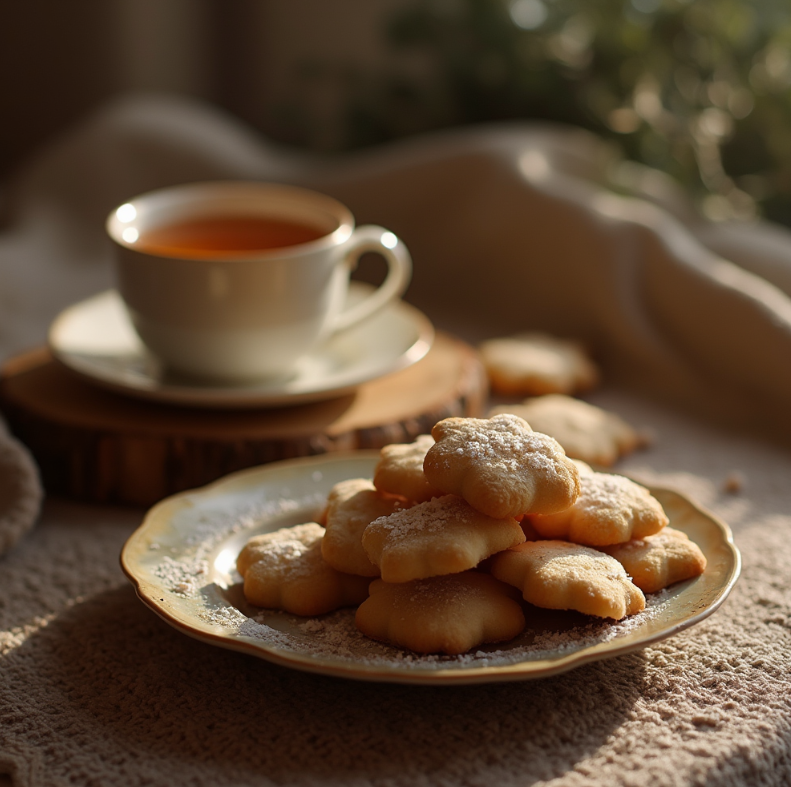
Lady Finger Cookies in Popular Culture
Lady finger cookies, with their light and delicate nature, have made their way into popular culture, particularly through culinary shows, cookbooks, and food blogs. Their use in desserts like tiramisu and trifles has made them a staple in both professional and home kitchens. Chefs and home cooks alike appreciate their versatility, often using them to create unique variations of traditional desserts or to introduce new flavor combinations.
Their appearance in television cooking shows, food documentaries, and even social media platforms like Instagram has contributed to their rise in popularity in recent years. As more people experiment with international cuisines, lady finger cookies have become an accessible ingredient for dessert innovation, particularly in no-bake recipes, such as no-bake cheesecakes and chilled desserts. The simplicity of lady fingers also appeals to those who want to make sophisticated-looking desserts with minimal effort.
The Science Behind Lady Finger Cookies
The Role of Eggs in Lady Finger Cookies
One of the key ingredients in lady finger cookies is eggs, which are vital for their light and airy texture. The egg whites are beaten until stiff peaks form, incorporating air into the mixture. This process is what gives lady finger cookies their characteristic lightness. The yolks add richness to the batter, contributing to the slightly sweet flavor and smooth texture.
Eggs also serve as a binding agent in the batter, helping the flour and sugar hold together and form a cohesive dough. The combination of these two elements—egg whites for structure and egg yolks for richness—is essential to the success of the recipe. Without eggs, achieving the desired light, crisp texture would be impossible.
The Importance of Proper Folding
Proper folding of the egg whites into the egg yolk mixture is a crucial step in making perfect lady finger cookies. Overmixing or undermixing can lead to a dense or lumpy texture, which is the opposite of what you want for this type of cookie. When you fold the ingredients together, you must be gentle to preserve the air trapped in the whipped egg whites.
The technique of folding ensures that the batter remains light and fluffy, giving the cookies the desired structure. This step is what allows the lady fingers to expand slightly during baking, making them crisp and airy without being too fragile.
Baking Process and Temperature
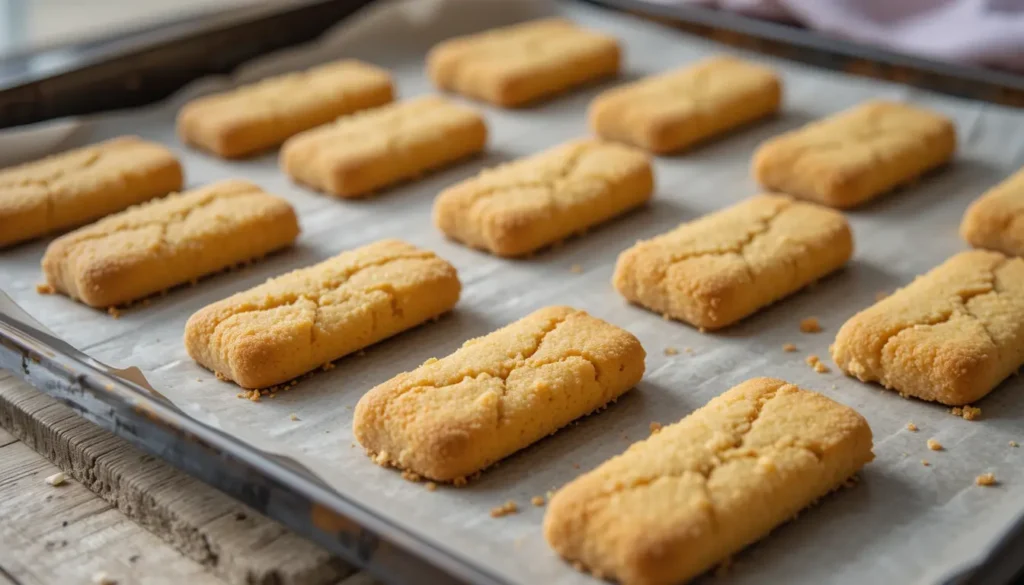
The temperature at which you bake lady finger cookies plays a significant role in their texture. They are traditionally baked at a relatively low temperature, around 350°F (175°C), to ensure they dry out without becoming too hard or overly brown. The cookies need to cook slowly to allow their delicate structure to form while maintaining their light and airy quality.
Baking them at too high a temperature could cause the cookies to puff up too much and then collapse, leaving you with a dense and chewy result. By baking at a moderate temperature, you allow the moisture in the cookies to evaporate gradually, ensuring they become crisp without becoming too dry or brittle.
Alternatives to Traditional Lady Finger Cookies
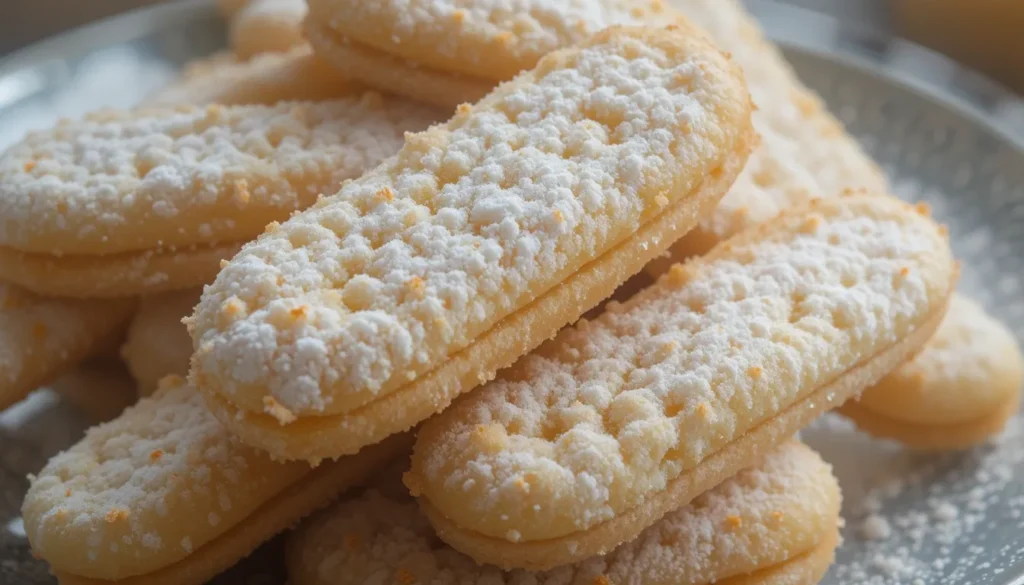
Gluten-Free Lady Finger Cookies
For those with gluten sensitivities or dietary restrictions, making gluten-free lady finger cookies is an excellent alternative. Instead of using regular wheat flour, gluten-free flour blends or almond flour can be substituted to create a similar texture. Almond flour, for example, provides a slightly nutty flavor and a more delicate texture than traditional flour, but still maintains the airy structure needed for lady finger cookies.
When making gluten-free versions, it’s important to choose a flour blend that includes xanthan gum or another binding agent to mimic the gluten’s elasticity. Additionally, using egg substitutes like aquafaba (whipped chickpea brine) can help create the necessary volume and lightness.
Vegan Lady Finger Cookies
For those following a vegan lifestyle, vegan lady finger cookies are entirely possible to make. Traditional lady finger recipes rely on eggs to create their structure and texture, but you can substitute them with plant-based alternatives. For example, people can whip aquafaba, the liquid from canned chickpeas, to form stiff peaks just like egg whites, giving the cookies the necessary texture.
Flaxseed or chia seed eggs, which are made by mixing ground flax or chia seeds with water, are another common substitute. These plant-based alternatives allow you to recreate the lightness of traditional lady finger cookies without using animal products.
Sugar-Free Lady Finger Cookies
Another variation of lady finger cookies can be made for those who need to reduce their sugar intake. Sugar-free lady finger cookies can be made using natural sugar substitutes like stevia, erythritol, or monk fruit sweeteners. These alternatives provide the sweetness needed without spiking blood sugar levels, making the cookies suitable for diabetic or low-sugar diets.
The texture may vary slightly depending on the sweetener used. However, with a bit of experimentation, you can create sugar-free lady finger cookies that are just as light and crisp as their sugary counterparts.
Lady Finger Cookies Around the World: Global Variations

Lady Fingers in Latin America
In Latin America, people use lady finger cookies in a variety of desserts, often inspired by European traditions. In countries like Argentina, Chile, and Mexico, lady finger cookies are popular in layered desserts with fresh fruit, custard, or meringue. The Latin American version may be slightly sweeter and denser than the traditional Italian savoiardi. However, it still maintains the light texture that makes it versatile in layered treats.
One popular dessert in the region is torta helada, an ice cream cake made with layers of lady fingers, whipped cream, and chocolate or fruit fillings. This dessert highlights how lady fingers absorb and complement different flavors, making them a key ingredient in many Latin American sweet treats.
Lady Fingers in Asia
In Asia, lady finger cookies have found their place in a variety of desserts. For instance, in Japan, people sometimes use lady finger cookies in daifuku (rice cake) recipes or layer them into matcha-flavored parfaits. Similarly, in some regions of China and Taiwan, people incorporate lady fingers into chilled desserts, combining them with fresh fruits like mango and coconut milk to create a refreshing treat. The versatility of lady fingers makes them a perfect fit for the wide variety of flavor profiles found across Asian cuisines.
FAQs About Lady Finger Cookies
1. Are lady finger cookies gluten-free?
Traditional lady finger cookies contain wheat flour, so they are not gluten-free. However, you can make gluten-free versions by using alternatives such as rice flour, almond flour, or gluten-free flour blends.
2. What is the difference between lady fingers and sponge cake?
While both lady fingers and sponge cake are light and airy, the main difference lies in their shape and texture. Lady fingers are individual, long, and thin biscuits, whereas sponge cake is baked as a single, thick layer. Lady fingers are typically crispier and less moist than sponge cake.
3. Can lady finger cookies be used in desserts other than tiramisu?
Absolutely! While they are most commonly used in tiramisu, lady finger cookies are also great for other layered desserts like trifles, charlottes, and ice cream cakes. They can even be used as a base in fruit parfaits or chilled desserts.
For those interested in expanding their knowledge of various desserts, we have a great resource on different types of cheesecake. Visit our article on What is the Best Flavor of Cheesecake? to explore more.
Conclusion
Lady finger cookies, originating in Italy, have become a beloved ingredient in numerous classic desserts. Whether you enjoy them in tiramisu, a British trifle, or a French Charlotte, these delicate treats remain timeless favorites. Their versatility, light texture, and rich history make them essential in kitchens around the world. As you experiment with these cookies in your own recipes, you’ll notice how they enhance the flavor and texture of your favorite desserts. Whether using them in their traditional form or one of their many variations, they will continue to be a staple in classic and modern kitchens.

